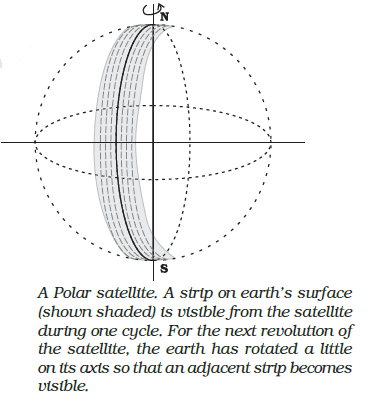8.12 Geostationary and polar satellites
An interesting phenomenon arises if we arrange the value of \(\left(R_{\mathrm{E}}+h\right)\) such that \(T\) becomes equal to 24 hours.
\(
T=\frac{2 \pi\left(R_E+h\right)}{V}=\frac{2 \pi\left(R_E+h\right)^{3 / 2}}{\sqrt{G M_E}}
\)
If the circular orbit is in the equatorial plane of the earth, such a satellite, having the same period as the period of rotation of the earth about its own axis would appear stationery viewed from a point on earth. The \(\left(R_{\varepsilon}+h\right)\) for this purpose works out to be large as compared to \(R_{\varepsilon}\) :
\(
R_E+h=\left(\frac{T^2 G M_E}{4 \pi^2}\right)^{1 / 3}
\)
and for \(T=24\) hours, \(h\) works out to be \(35800 \mathrm{~km}\). which is much larger than \(R_{\varepsilon}\). Satellites in a circular orbit around the earth in the equatorial plane with \(T=24\) hours are called Geostationary Satellites. Clearly, since the earth rotates with the same period, the satellite would appear fixed from any point on earth. It takes very powerful rockets to throw up a satellite to such large heights above the earth but this has been done in view of the several benefits of many practical applications.

It is known that electromagnetic waves above a certain frequency are not reflected from the ionosphere. Radio waves used for radio broadcasts which are in the frequency range 2 \(\mathrm{MHz}\) to \(10 \mathrm{MHz}\), are below the critical frequency. They are therefore reflected by the ionosphere.